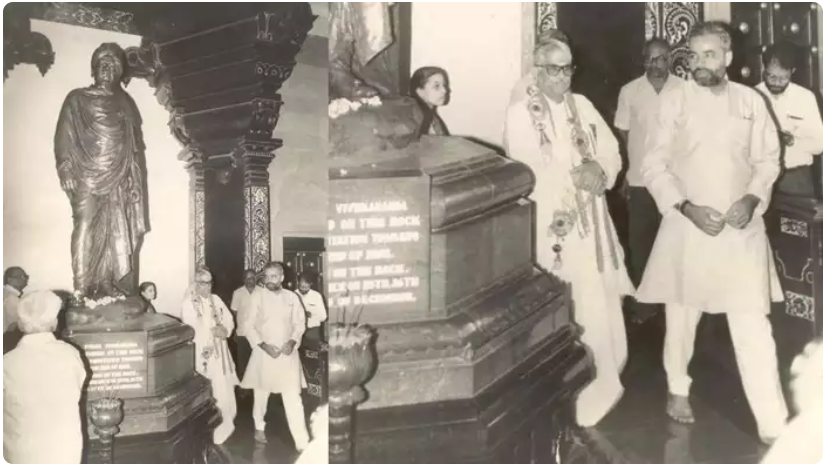Table of Contents
Recently, the Prime Minister Narendra Modi retreated to Kanniyakumari after a long few months of election campaigning. In 2019 he had retreated to the Kedarnath caves after Modi’s 2019 election campaign was over. Kedarnath is often visited for seeking pardons and blessings. It is where Shiv ji resides, and the temple was established by the Pandavas. It is the highest altitude Shiva temple in the country as well. Kedarnath is one of the 12 Jyotrilingas, and is deeply associated with the masculine energy of Lord Shiva
In contrast, this year PM Narendra Modi has chosen to do dhyanam (meditation) at Swami Vivekananda’s memorial in Kanniyakumari, the southernmost point of Bharat’s geography. This memorial is associated with Kumari Amman’s temple, and the deity Kumari Amman signifies purity, devotion and strength. Kumari Amman (Parvati Devi before marriage) had killed king Banasura on this spot, as he had a vardaan (boon) that only a virgin goddess could kill him. Afterwards, Parvati devi performed penance at this very place to get the courage to marry Shiv ji and make Shiva return to his worldly duties.
We can clearly see the contrast between the two choices of pilgrimage: north and south, shiva and parvati, pardons and purity, linga and kumari, etc. Both temples are also associated with Adi Shankaracharya, who established both Kedarnath and Kumari Amman. Swami Vivekananda also considered Adi Shankaracharya the greatest teacher of Vedanta, or Vedic Philosophy. Hence, we can see a lineage of reverence between these figures.
PM Modi’s history with Swami Vivekananda
Prime Minister Narendra Modi has often expressed his admiration for Swami Vivekananda, considering Vivekananda one of his biggest sources of inspiration. Narendra Modi, who grew up in relative poverty in his youth, was given several books on Swami Vivekananda by a lawyer and RSS worker named Lakshmanrao Inamdar. This had a profound impact on Modi’s life, and eventually contributed to his choice to become a pilgrim at 17, shortly after his marriage, and even to join politics, when Modi returned as a 19 year old at the request of his father.
Lakshmanrao Inamdar encouraged a young Modi to join politics, as Modi can apply the teachings of Vivekananda to serving others around him.
This is why, Modi’s spiritual guru in his head has always been Swami Vivekananda. This is why Swami Vivekananda’s teachings have a profound impact on Modi’s memory, as they are strongly associated with Modi’s youth and Modi’s childhood.
What Kanniyakumari Meant to Swami Vivekananda
While there is clearly a reverence for Narendra Modi for Swami Vivekananda, what is the importance of Kanniyakumari to Swami Vivekananda and what is the importance of Adi Shankaracharya to Narendra Modi ji?
After traveling for several months across the length and breadth of Bharat to prepare for the ‘Parliament of the World’s Religions’, in 1892 Swami Vivekananda returned to Kanniyakumari feeling distraught. Vivekananda was disturbed by the poverty that was present across the country due to the British rule. Vivekananda decided to undress and swim across the ocean on a whim, when Vivekananda reached a rock.
Vivekananda sat and did dhyanam (meditated) on the rock for 3 days and 3 nights, and that is when Vivekananda had an epiphany. Vivekananda realized during his dhyanam that the gap between the Eastern way of thinking and the Western way of thinking (eastern and western philosophy) should be bridged to increase the understanding between the British and the Indians.
Vivekananda subsequently left for the USA’s Chicago to attend the ‘Parliament of the World’s Religions’ in 1893, knowing exactly what to say, and represented Sanatan Dharm and Bharat against other world religions like Islam, Christianity, Judaism, and even other indigenous religions such as Buddhism and various Animist religions.
Vivekananda spoke about how all religions have a unity of destination. Vivekananda spoke about the tolerance Sanatan Dharm shows to various panths across the world. This speech also established the mood for all of Vivekananda’s future works, which changed religious discourse globally forever. It was the moment that defined Swami Vivekananda as a spiritual guru back in the day.
The Parallels with Modi
The parallels between Modi and his guru Vivekananda are somewhat obvious. Still, both are vastly different. Vivekananda was a primarily religious guru, whereas Modi is mostly a political leader. Still, let’s discuss the similarities.
Much like Vivekananda had traveled the country to collect knowledge and prepare for his speech in the Parliament of the World’s Religions, Modi campaigned across the country to discover people’s aspirations and needs. Where Vivekananda saw abject poverty from up close, Modi has constantly attacked the opposition for their intellectual poverty. One saw spiritually bridging the east and the west as his mission. The other sees politically bridging the east and the west as his mission. Modi clearly hopes to receive the same amount of political clarity as Vivekananda did spiritual clarity.
There is also a common thread of ideation between Adi Shankaracharya, Swami Vivekananda and Narendra Modi, when it comes to uniting the Sanatani civilization across the four corners of the land, whether spiritual or political. While Modi follows in the footsteps of his earliest Guru, whether his convictions attain fruition or not will be seen in 2029 after Modi’s third term is over, or in 2024 if Modi loses next week.
